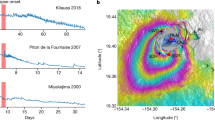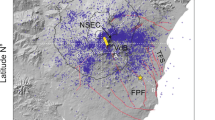Abstract
Regional-scale faulting, particularly in strike-slip tectonic regimes, is a relatively poorly constrained factor in the formation of caldera volcanoes. To examine interactions between structures associated with regional-tectonic strike-slip deformation and volcano-tectonic caldera subsidence, we made scaled analogue models. Tabular (sill-like) inclusions of creamed honey in a sand/gypsum mix replicated shallow-level granitic magma chambers in the brittle upper crust. Lateral motion of a base plate sited below half the sand/gypsum pack allowed simulation of regional strike-slip deformation. Our experiments modelled: (1) strike-slip deformation of a homogeneous brittle medium; (2) strike-slip deformation of a brittle medium containing a passive magma reservoir; (3) caldera collapse into sill-like magma reservoirs without regional strike-slip deformation; and (4) caldera collapse into sill-like magma reservoirs after regional strike-slip deformation. Our results show that whilst the magma chamber shape principally influences the development and geometry of volcano-tectonic collapse structures, regional-tectonic strike-slip faults (Riedel shears and Y-shears) may affect a caldera’s structural evolution in two main ways. Firstly, regional strike-slip faults above the magma chamber may form a pre-collapse structural grain that is exploited and reactivated during subsidence. Our experiments show that such faults may preferentially reactivate where tangential to the collapse area and coincident with the chamber margins. In this case, volcano-tectonic extension in the caldera periphery tends to localise on regional-tectonic faults that lie just outside the chamber margins. In addition, volcano-tectonic reverse faults may link with and reactivate pre-collapse regional-tectonic faults that lie just inside the chamber margins. Secondly, where regional-tectonic strike-slip faults define corners in the magma chamber margin, they may halt the propagation of volcano-tectonic reverse faults. The experiments also highlight the potential difficulties in assessing the relative contributions of volcano-tectonic and regional-tectonic subsidence processes to the final caldera structure seen in the field. Disruption of the pre-collapse surface by regional-tectonic faulting was preserved during coherent volcano-tectonic subsidence to produce a caldera floor of differentially-subsided fault blocks. Without definitive evidence for syn-eruptive growth faulting, thickness changes in caldera fill across such regional-tectonic fault blocks in nature could be mistaken as evidence for piecemeal volcano-tectonic collapse.













Similar content being viewed by others
References
Acocella V, Salvini F, Funiciello R, Faccenna C (1999) The role of transfer structures on volcanic activity at Campi Flegrei (Southern Italy). J Volcanol Geotherm Res 91:123–139
Acocella V, Cifelli F, Funiciello R (2000) Analogue models of collapse calderas and resurgent domes. J Volcanol Geotherm Res 104:81–96
Acocella V, Korme T, Salvini F, Funiciello R (2003) Elliptic calderas in the Ethiopian Rift: control of pre-existing structures. J Volcanol Geotherm Res 119:189–203
Acocella V, Funiciello R, Marotta E, Orsi G, de Vita S (2004) The role of extensional structures on experimental calderas and resurgence. J Volcanol Geotherm Res 129:199–217
Aldiss DT, Ghazali SA (1984) The regional geology and evolution of the Toba volcano-tectonic depression, Indonesia. J Geol Soc (Lond) 141:487–500
Basile C, Brun JP (1999) Transtensional faulting patterns ranging from pull-apart basins to transform continental margins: an experimental investigation. J Struct Geol 21:23–37
Bellier O, Sebrier M (1994) Relationship between tectonism and volcanism along the Great Sumatran fault zone deduced by SPOT image analyses. Tectonophysics 233:215–231
Bellier O, Bellon H, Sébrier M, Sutanto, Maury RC (1999) K-Ar age of the Ranau Tuffs: implications for the Ranau caldera emplacement and slip-partitioning in Sumatra (Indonesia). Tectonophysics 312:347–359
Benn K, Odonne F, de Saint Blanquat M (1998) Pluton emplacement during transpression in brittle crust; new views from analogue experiments. Geology 26:1079–1082
Bosworth W, Burke K, Strecker M (2003) Effect of stress fields on magma chamber stability and the formation of collapse calderas. Tectonics 22:1042
Branney MJ (1995) Downsag and extension at calderas: new perspectives on collapse geometries from ice-melt, mining, and volcanic subsidence. Bull Volcanol 57:303–318
Branney MJ, Kokelaar P (1994) Volcanotectonic faulting, soft-state deformation, and rheomorphism of tuffs during development of a piecemeal caldera, English Lake District. Geol Soc Amer Bull 106:507–530
Carr WJ, Quinlivan WD (1968) Structure of Timber Mountain resurgent dome, Nevada Test Site. Mem Geol Soc Amer 110:99–108
Chesner CA (1998) Petrogenesis of the Toba Tuffs, Sumatra, Indonesia. J Petrol 39:397–438
Cole JW, Milner DM, Spinks KD (2005) Calderas and caldera structures: a review. Earth-Sci Rev 69:1–26
Corti G, Moratti G, Sani F (2005) Relations between surface faulting and granite intrusions in analogue models of strike-slip deformation. J Struct Geol 27:1547–1562
Cruden AR (1998) On the emplacement of tabular granites. J Geol Soc (Lond) 155:853–862
Dingwell DB (1999) Granitic melt viscosities. Geol Soc Lond Spec Publ 168:27–38
Donnadieu F, Merle O (1998) Experiments on the indentation process during cryptodome intrusions; new insights into Mount St. Helens deformation. Geology 26:79–82
Dooley T, McClay K (1997) Analog modeling of pull-apart basins. Bull Am Assoc Pet Geol 81:1804–1826
Druitt TH, Sparks RSJ (1984) On the formation of calderas during ignimbrite eruptions. Nature 310:679–681
Girard G, van Wyk de Vries B (2005) The Managua Graben and Las Sierras-Masaya volcanic complex (Nicaragua); pull-apart localisation by an intrusive complex: results from analogue modelling. J Volcanol Geotherm Res 144:37–57
Goff F, Gardner JN (1994) Evolution of a mineralized geothermal system, Valles Caldera, New Mexico. Econ Geol 89:1803–1832
Goodman RE (1989) Introduction to rock mechanics. Wiley, New York
Hickman RG, Dobson PF, van Gerven M, Sagala BD, Gunderson RP (2004) Tectonic and stratigraphic evolution of the Sarulla graben geothermal area, North Sumatra, Indonesia. J Asian Earth Sci 23:435–448
Hildreth W, Mahood GA (1986) Ring-fracture eruption of the Bishop Tuff. Geol Soc Amer Bull 97:396–403
Holohan EP, Troll VR, Walter TR, Münn S, McDonnell S, Shipton ZK (2005) Elliptical calderas in active tectonic settings: an experimental approach. J Volcanol Geotherm Res 144:119–136
Hubbert MK (1951) Mechanical basis for certain familiar geologic structures. Geol Soc Amer Bull 62:355–372
Hutton DHW, Reavy RJ (1992) Strike-slip tectonics and granite petrogenesis. Tectonics 11:960–967
Jacques JM, Reavy RJ (1994) Caledonian plutonism and major lineaments in the SW Scottish Highlands. J Geol Soc (Lond) 151:955–969
Jellinek AM, DePaolo DJ (2003) A model for the origin of large silicic magma chambers: precursors of caldera-forming eruptions. Bull Volcanol 65:363–381
John DA (1995) Tilted middle Tertiary ash-flow calderas and subjacent granitic plutons, southern Stillwater Range, Nevada; cross sections of an Oligocene igneous center. Geol Soc Amer Bull 107:180–200
Kennedy B, Stix J, Vallance JW, Lavallée Y, Longpré M-A (2004) Controls on caldera structure: results from analogue sandbox modeling. Geol Soc Amer Bull 116:515–524
Kokelaar P, Moore I (2006) Classical areas of British geology: Glencoe caldera volcano, Scotland. British Geological Survey memoir. British Geological Survey, Keyworth
Komuro H (1987) Experiments on cauldron formation: a polygonal cauldron and ring fractures. J Volcanol Geotherm Res 31:139–149
Lipman PW (1997) Subsidence of ash-flow calderas; relation to caldera size and magma-chamber geometry. Bull Volcanol 59:198–218
Marti J, Ablay GJ, Redshaw LT, Sparks RSJ (1994) Experimental studies of collapse calderas. J Geol Soc (Lond) 151:919–929
Molyneux SJ, Hutton DHW (2000) Evidence for significant granite space creation by the ballooning mechanism; the example of the Ardara Pluton, Ireland. Geol Soc Amer Bull 112:1543–1558
Moore I, Kokelaar P (1998) Tectonically controlled piecemeal caldera collapse; a case study of Glencoe Volcano, Scotland. Geol Soc Amer Bull 110:1448–1466
Nappi G, Renzulli A, Santi P (1991) Evidence of incremental growth in the Vulsinian calderas (central Italy). J Volcanol Geotherm Res 47:13–31
Orsi G, De Vita S, Di Vito M (1996) The restless, resurgent Campi Flegrei nested caldera (Italy): constraints on its evolution and configuration. J Volcanol Geotherm Res 74:179–214
Ramelow J, Riller U, Romer R, Oncken O (2006) Kinematic link between episodic trapdoor collapse of the Negra Muerta caldera and motion on the Olacapato-El Toro fault Zone, southern central Andes. Int J Earth Sci 95:529–541
Rampino MR, Self S (1992) Volcanic winter and accelerated glaciation following the Toba super-eruption. Nature 359:50–52
Riller U, Petrinovic I, Ramelow J, Strecker MR, Oncken O (2001) Late Cenozoic tectonism, collapse caldera and plateau formation in the Central Andes. Earth Planet Sci Lett 188:299–311
Roche O, Druitt TH, Merle O (2000) Experimental study of caldera formation. J Geophys Res 105:395–416
Roman-Berdiel T (1999) Geometry of granite emplacement in the upper crust; contributions of analogue modelling. Geol Soc Lond Spec Pub 168:77–94
Scaillet B, Holtz F, Pichavant M (1997) Rheological properties of granitic magmas in their crystallization range. In: Bouchez JL, Hutton DHW, Stephens WE (eds) Granite: from segregation of melt to emplacement fabrics. Kluwer, Dordrecht, pp 11–29
Schellart WP (2000) Shear test results for cohesion and friction coefficients for different granular materials; scaling implications for their usage in analogue modelling. Tectonophysics 324:1–16
Schöpfer MPJ, Steyrer HP (2001) Experimental modeling of strike-slip faults and the self-similar behaviour. Geol Soc Am Mem 193:21–27
Schultz RA (1996) Relative scale and the strength and deformability of rock masses. J Struct Geol 18:1139–1149
Self S, Rampino MR, Newton MS, Wolff JA (1984) Volcanological study of the great Tambora eruption of 1815. Geology 12:659–663
Skilling IP (1993) Incremental caldera collapse of Suswa volcano, Gregory Rift Valley, Kenya. J Geol Soc (Lond) 150:885–896
Smith RL, Bailey RA (1968) Resurgent cauldrons. Geol Soc Am Mem 116:613–662
Spinks KD, Acocella V, Cole JW, Bassett KN (2005) Structural control of volcanism and caldera development in the transtensional Taupo Volcanic Zone, New Zealand. J Volcanol Geotherm Res 144:7–22
Troll VR, Walter TR, Schminke H-U (2002) Cyclic caldera collapse: Piston or piecemeal subsidence? Field and experimental evidence. Geology 30:135–138
Ventura G, Vilardo G, Milano G, Pino NA (1999) Relationships among crustal structure, volcanism and strike-slip tectonics in the Lipari-Vulcano volcanic complex (Aeolian Islands, southern Tyrrhenian Sea, Italy). Phys Earth Planet Inter 116:31–52
Walter TR, Troll VR (2001) Formation of caldera periphery faults: an experimental study. Bull Volcanol 63:191–203
Woodcock NH, Schubert C (1994) Continental strike-slip tectonics. In: Hancock PL (ed) Continental deformation. Pergamon, Oxford, pp 251–263
Acknowledgements
We thank John Graham, Thomas Walter, Olivier Roche, and Tim Druitt for support, technical advice, and helpful discussion. An award to VRT and EPH from the Enterprise Ireland International Collaboration Programme greatly aided this work. EPH also appreciates financial assistance from the Department of Geology, the Graduate Studies Office and the Trinity Trust, Trinity College Dublin. Incisive and constructive reviews by G. Girard, U. Riller, O. Roche, and an anonymous reviewer helped us to significantly improve this paper.
Author information
Authors and Affiliations
Corresponding author
Additional information
Editorial responsibility: J Stix
Rights and permissions
About this article
Cite this article
Holohan, E.P., van Wyk de Vries, B. & Troll, V.R. Analogue models of caldera collapse in strike-slip tectonic regimes. Bull Volcanol 70, 773–796 (2008). https://doi.org/10.1007/s00445-007-0166-x
Received:
Accepted:
Published:
Issue Date:
DOI: https://doi.org/10.1007/s00445-007-0166-x




